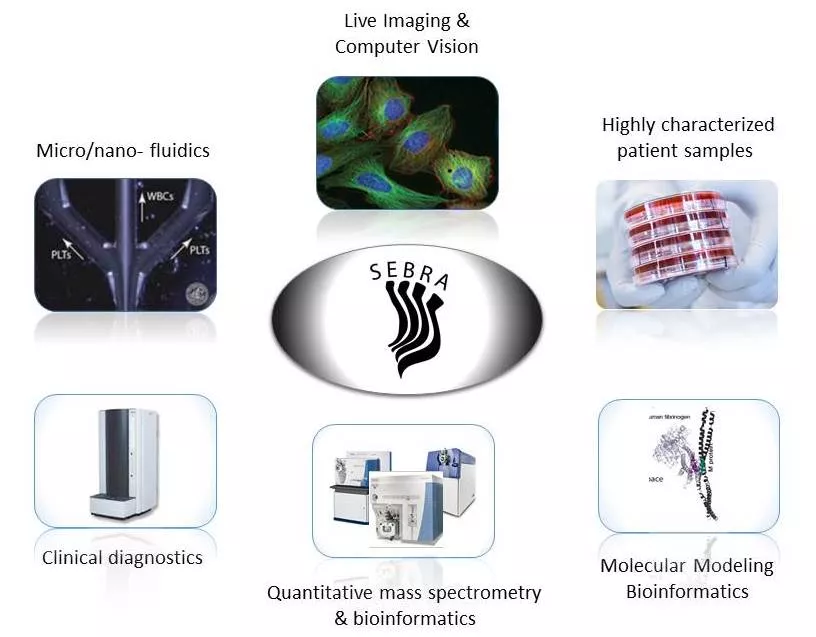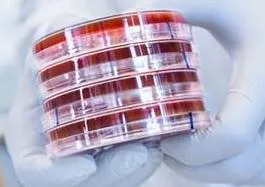Key Competencies
Advanced microscopy
SEBRA environment uses state-of-the-art fluorescence microscopy to study live host-bacteria interactions. We use Nikon’s new live imaging platform, Ti2, fully equipped with incubator and gas control. The microscope is placed in a biosafety level 2 pathogen lab, to allow for studies of important sepsis-related pathogens.
The other system we have is Nikon’s super-resolution microscope, SIM-E, allowing for high resolution multi-color experiments, also with a live imaging option.Live imaging is, in contrast to conventional microscopy, geared towards obtaining images of non-killed pathogens. As the interactions may depend on the vital state of the pathogen this is an important tool in acquiring new knowledge of host-pathogen interactions.
Flow cytometry
Flow cytometry is a powerful technique that enables detection, quantification and functional assessment of distinct cells within mixed populations in a single sample. Furthermore, cell associated ligands and receptors can also be investigated and distinguished using this technique. Flow cytometry is particularly useful in sepsis research when applied to the study of immune cells, bacteria, and/or bacterial products, in small volumes of whole blood sampled from experimental infection or clinical infection in patients.
Modelling infection
The ability to model any infectious disease in a susceptible animal is fundamental to understanding and unravelling the complexity of disease pathogenesis, and for the assessment of potential prognostic and therapeutic strategies. Sepsis is a particularly challenging clinical syndrome since the patient group is so heterogeneous, for example in terms of bacterial agent, the primary site of infection, immune status of the patient, and the distinct kinetics of the syndrome in individual patients.
The advantage of modelling sepsis is that here we can control the bacterial agent, site of infection, infectious dose, and time from infection in a way which is never possible to stratify for in a patient population. This approach can therefore provide vital mechanistic insight on the complementary processes and kinetics underlying sepsis.
Mass spectrometry
The rapid and dramatic evolution of biological mass spectrometry (MS) has introduced a multitude of new mass spectrometry-based proteomics techniques into life science research, ranging from large-scale quantification of proteomes and post-translational modifications to investigations of protein interactions and quaternary protein structures.
Within SEBRA we focus on developing novel disruptive MS-based approaches in quantitative (SWATH-MS) and structural (targeted cross-linking TX-MS) proteomics. With these techniques we aim to improve the molecular definition of sepsis to enable molecular sub-classification that can be used as future biomarkers for improved diagnosis, prediction of prognosis and for the assignment of novel future treatment opportunities.
Microbiology
An important factor for improving sepsis care management is rapid identification of disease causing pathogen and resistance pattern, in particular in the light of the increasing antibiotics resistance. Additionally, detailed readout of the bacterial pathogens virulence type and ability to bind human host proteins is critical for full understanding of how bacterial subtypes can influence the molecular host response. Improved technologies for determining bacterial species, virulence grade and antibiotics resistance patterns represent unmet needs.
Members from the SEBRA constellation have introduced MALDI-TOF mass spectrometry as a key technology for bacterial identification in the clinical routine analysis. The aim is to further expand the capabilities of MALDI-TOF MS and other methodologies to provide faster diagnostics for sepsis patients.
Biobanks
Biobanks are collections of biological samples of human origin, commonly plasma samples or tissue specimens, and represent a tremendous asset for researchers. Access to biobanks is a controlled process and enables researchers to apply scientific questions or methodologies to e.g. historic samples, larger sample sets than they themselves could acquire, or samples collected in a completely different scientific background.
SEBRA has both used and initiated sample collections to further the understanding of sepsis and its consequences.
Acoustofluidics
Acoustophoresis utilises ultrasonic (MHz-range) resonances in microchannels that exert forces on cells and particles that are dependent of the acoustophysical properties of each cell type. Different cell types display phenotype specific acoustic fingerprints which provides opportunities for continuous flow based cell separation. Important applications encompass separation of leukocytes, erythrocytes and platelets and leukocyte subtypes. Acoustophoretic separation of bacteria from blood is currently developed as a pre-processing step prior to bacteria enrichment and subsequent molecular analysis in sepsis diagnostics.
Acoustic trapping is a technology related to acoustophoresis in that it uses acoustic standing wave forces in microcapillaries to retain cells against flow. By generating a local ultrasonic resonance in a microchannel a localised acoustic force-field is obtained that can retain and enrich cells from flow at cell sizes down to about 2 micrometer. Recent development has now also enabled trapping of bioparticles in the submicrometer range such as bacteria and extra cellular vesicles. By combining acoustophoretic separation of bacteria from blood with acoustic trapping and bacteria enrichment rapid sepsis diagnostics from whole blood samples may be accomplished.
Key Competencies
Advanced microscopy
Flow cytometry
Modelling infection
Mass spectrometry
Microbiology
Biobanks
Acoustofluidics



